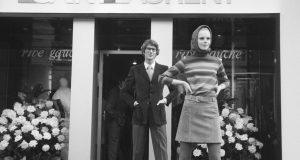
Fashion is a reflection of society, and throughout history, it has evolved in step with cultural, economic, and technological changes. Within this constant transformation, prêt-à-porter has held a key position, marking a turning point in the way people relate to clothing, design, and the concept of luxury.
For centuries, high-quality clothing was a privilege reserved for the elite: garments were made to measure in haute couture ateliers, where the artisanal process and attention to detail made each piece unique and exclusive. However, this model no longer met the needs of a new, emerging audience—more urban, more dynamic, and with its own aesthetic aspirations—that began to grow in the mid-20th century.
It was in this context that prêt-à-porter—literally “ready to wear”—emerged as a middle ground between unattainable luxury and mass production. This new category allowed fashion houses and designers to offer quality collections with refined design, produced in series but with strict creative control. A new paradigm was born in the industry: a more accessible form of fashion, without giving up style, innovation, or the symbolic value of a well-designed garment.
Since then, prêt-à-porter has not only become a commercially successful format, but also a true platform for artistic and cultural expression. It is the space where brands experiment, communicate their identity, and connect with a diverse and global audience. Today, it remains a relevant and responsible way to create and consume fashion, adapting to contemporary challenges such as sustainability, social impact, and the digitalization of the sector.
In this article, we will explore in depth what prêt-à-porter means, its origins, how it differs from other categories such as haute couture or fast fashion, and which brands and designers have turned it into a key reference of modern style.
Prêt-à-porter emerged as an innovative response to the profound social and economic changes that transformed society in the 20th century. Until that moment, high-quality fashion was strictly associated with haute couture—an exclusive world where each garment was conceived as a work of art, made to measure. Only a small, privileged audience could access the creations of major fashion houses, limiting the dissemination of design and the concept of luxury.
The emergence of prêt-à-porter— a French term that literally means “ready to wear”—represented a true revolution in the fashion industry. Starting in the 1950s, the world began to experience a cultural transformation marked by the expansion of the middle class, the massive incorporation of women into the workforce, and a new collective desire to express identity through clothing. These changes created an urgent need: a way of dressing that combined style, modernity, and accessibility, without depending on the time and cost of traditional tailoring.
The textile industry had already undergone technical advancements that made mass production of garments possible, but one essential link was missing: connecting that industrial capacity with the creative talent of leading designers. It was then that visionary figures began to create collections designed by professionals with a clear artistic vision, intended to be manufactured in standard sizes and sold on a larger scale.
Among them, Yves Saint Laurent stands out as a key figure, considered by many to be the father of modern prêt-à-porter. In 1966, he launched his Rive Gauche line— a collection parallel to his haute couture atelier that offered sophisticated design at a more accessible level. His proposal democratized luxury: a woman could now purchase a designer garment without belonging to an economic elite. This decision not only changed the rules of the market, but also challenged the boundaries between art, industry, and consumption.

From that moment on, other brands and historic fashion houses followed the same path. Prêt-à-porter became a new category within fashion, with its own runways, calendars, distribution channels, and audiences. Fashion weeks began to include shows dedicated exclusively to these collections, solidifying their cultural and commercial relevance.
Over time, prêt-à-porter has evolved from a disruptive innovation to the strategic core of many luxury brands. It represents a sophisticated and functional alternative to mass consumption and remains a key reference for understanding how design can be accessible without losing its essence.
In the world of fashion, prêt-à-porter literally means “ready to wear.” It refers to garments that are part of collections designed by major brands or fashion houses, produced in series but with a strong emphasis on design.
Unlike haute couture, which is based on artisanal and exclusive creation for each individual, prêt-à-porter offers designer fashion to a broader audience. Its price is more accessible, though it still reflects the quality and aesthetic value of the product.
This format has been key in bringing designers’ creativity closer to consumers’ everyday lives, and it remains a reference for those who want to dress with style—without relying on made-to-measure processes.
Prêt-à-porter has evolved significantly since its beginnings, adapting to the changing demands of the market, the fashion industry, and society at large. Today, it represents far more than an intermediate fashion category—it is a creative space where innovation, functionality, and aesthetics converge. Below are the main characteristics that define contemporary prêt-à-porter:
Although prêt-à-porter lacks the artisanal exclusivity of haute couture, its garments do not compromise on design. Each collection is conceived with a clear aesthetic intention, aligned with the brand’s identity. Designers explore silhouettes, fabrics, prints, and colors with an artistic mindset—while always considering practicality. In this way, prêt-à-porter blends runway creativity with the reality of the everyday wardrobe.
One of the defining traits of prêt-à-porter is its ability to be mass-produced, setting it apart from made-to-measure garments. However, unlike fast fashion, this production takes place in moderate volumes and under strict quality control. Many fashion houses limit the number of units per item or launch capsule collections to preserve a sense of luxury and exclusivity.
Prêt-à-porter pieces are typically crafted from noble or high-tech fabrics that ensure a good drape, durability, and comfort. While they don’t reach the detailed craftsmanship of haute couture, finishes are polished, cuts are precise, and proportions are carefully studied. This results in a major difference compared to the low-cost garments of fast fashion.
Another key characteristic of prêt-à-porter is its price point. While more accessible than haute couture, these garments are not inexpensive. The value of a prêt-à-porter piece lies in its balance: customers pay for design, quality, brand prestige, and a more ethical production process. It has become an attractive option for a consumer base that values conscious fashion without falling into impulsive consumption.
In recent years, prêt-à-porter has played a crucial role in the transformation of the fashion industry toward more sustainable and socially conscious practices. Many brands are adopting policies of traceability, using recycled materials, introducing gender-neutral collections, embracing body diversity, and collaborating with social initiatives. The result is a more responsible approach to fashion that meets not only aesthetic needs but also the values of a new generation of consumers.
Prêt-à-porter has also become a laboratory for experimentation among designers. From incorporating smart textiles to exploring new show formats—like digital or immersive runways—and even integrating artificial intelligence into the creative process, this format allows brands to evolve and innovate without losing their essence.
Although they are sometimes confused, there are clear differences between these three fashion formats:
Haute couture represents luxury in its purest form. These are unique garments, handcrafted in specialized ateliers and tailored to each individual. The level of detail, the materials used, and the production time are exceptional—factors that significantly increase the price and limit access to a very select audience.
At the opposite end is fast fashion, characterized by the mass and rapid production of garments inspired by the latest runway trends. These pieces are extremely low-cost and designed to rotate quickly, which raises serious concerns from both a social and environmental perspective.
Prêt-à-porter occupies the middle ground. It offers collections designed by renowned professionals, with notable quality and more moderate production levels. Its target audience seeks style, uniqueness, and durability—without reaching the extremes of either exclusive luxury or disposable consumption.
Ultimately, the main differences lie in how the garments are produced, the quality of each piece, the final price, and the kind of relationship each format establishes with the person wearing it.
Today, prêt-à-porter is the strategic and commercial core of most major fashion houses. Although it was born as an alternative to haute couture, it has since developed its own identity and become the most common—and profitable—way to present collections to the general public, without compromising on design or luxury.
From historic houses to contemporary and emerging brands, many have made prêt-à-porter a central expression of their creative DNA, adapting their aesthetic vision to faster production and global distribution.
Some of the greatest designers in fashion history have played a key role in establishing prêt-à-porter as a category. Their collections have served as a reference point for understanding how the art of couture can be brought into everyday life.
Yves Saint Laurent: Considered one of the pioneers of modern prêt-à-porter, he revolutionized the fashion system with his Rive Gauche line, launched in 1966. With it, he brought the concept of designer clothing to a broader public without sacrificing sophistication. He introduced new ways for women to dress with freedom and attitude—from the iconic tuxedo suit to sheer, boundary-pushing looks.
Chanel: Under the direction of Karl Lagerfeld (and now Virginie Viard), Chanel turned its ready-to-wearcollections into highlights of the global fashion calendar. With theatrical runway shows and designs that reinterpret the house’s classic codes—such as tweed, pearls, and black—Chanel demonstrates how prêt-à-porter can preserve tradition while continuing to innovate.
Dior: Led by Maria Grazia Chiuri, Dior has used its prêt-à-porter collections as a platform to express messages of female empowerment and social commentary, all while maintaining the brand’s signature timeless elegance.
Loewe: Under the creative direction of Jonathan Anderson, Loewe has turned prêt-à-porter into a space for formal experimentation. The brand’s collections combine art, craftsmanship, and contemporary design, making it one of the best examples of how to balance creativity with commercial appeal.


Beyond the world of haute couture and iconic designers, many contemporary and commercial brands have embraced prêt-à-porter as their natural field of expression. These labels combine a clear aesthetic vision with sustainable business models and accessible formats for a global audience.
The Row: Founded by Mary-Kate and Ashley Olsen, The Row offers a sober, minimalist, and ultra-high-quality approach to fashion. Its prêt-à-porter collections embody understated luxury, focusing on form, detail, and timeless elegance.
Isabel Marant: Known for her effortlessly chic Parisian style, Marant blends bohemian influences with everyday wearability. Her prêt-à-porter pieces reflect freedom and relaxed sophistication, ideal for the modern urban woman.
Acne Studios: This Swedish brand merges conceptual fashion with functionality. With a Scandinavian aesthetic and strong ties to the art world, Acne Studios has built a global identity rooted in creative expression.
COS: While positioned at a more accessible price point, COS embraces the values of prêt-à-porter through structured silhouettes, timeless design, and a commitment to sustainability. It appeals to consumers seeking quality, practicality, and minimalist elegance.
Jacquemus: One of the most influential designers of the new generation, Simon Porte Jacquemus has built a powerful prêt-à-porter brand with Mediterranean roots, bold silhouettes, and storytelling-driven campaigns. His collections are youthful, sensual, and instantly recognizable.
Other notable examples include Victoria Beckham, JW Anderson, Proenza Schouler, and Tibi—all of whom have made prêt-à-porter a central pillar of their creative and commercial strategy.
At a time when the fashion industry is undergoing a profound transformation—driven by digitalization, environmental concerns, and shifts in consumer behavior—prêt-à-porter continues to play a key role. Its relevance has not only endured, but strengthened, as it offers a balanced response to today’s challenges and serves as a bridge between creativity, accessibility, and responsibility.
Unlike haute couture, which represents exclusive, artisanal luxury, and fast fashion, which thrives on immediacy and mass production, prêt-à-porter strikes a thoughtful middle ground. It provides well-designed, high-quality garments made for real people, addressing both the desire for style and the demand for meaningful consumption.
One reason for its lasting appeal is its ability to evolve. Prêt-à-porter has embraced innovation—integrating new technologies, adopting more sustainable business models, expanding size ranges, and championing diversity and inclusion. Leading brands have reimagined their production and distribution processes, introducing recycled materials, limited collections, and transparent sourcing, all of which contribute to a more responsible fashion industry.
Beyond function, prêt-à-porter is also a powerful storytelling platform. Each season, designers use it to present narratives, express their identity, and connect emotionally with audiences. The runway remains a key stage for showcasing these collections, while retail spaces—both physical and digital—turn them into tangible lifestyle experiences.
Ultimately, prêt-à-porter remains relevant because it resonates with contemporary values. To wear a prêt-à-portergarment today is not only an aesthetic choice—it’s a conscious one. It means valuing design, paying a fair price, and supporting an industry that is striving to be more ethical and inclusive. In a world saturated with throwaway fashion, prêt-à-porter offers durability, beauty, and a sense of purpose.
Compartir